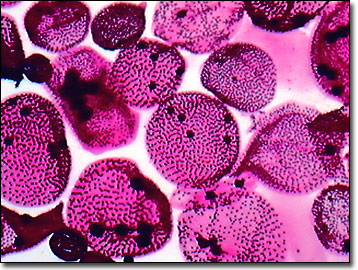Brightfield Digital Image Gallery
Volvox
In the division Chlorophyta (green protists), Volvox is a colonial form made up of 500 to 60,000 biflagellated cells embedded in a gelatinous wall. The largest colonies exceed one millimeter in diameter and are easily visible to the naked eye.

Assuming a semi-transparent hollow spherical shape, the colonies (coenobia) are about the size of a pinhead. To some systematists, this colonial organism has a dual nature, placed by zoologists in the order Volvocida, but classified by botanists as green algae, Chlorophyta. Globally, twenty species of Volvox are known to exist, with most species occurring in tropical and subtropical areas.
Volvox colonies are either sexual or asexual. In addition to biflagellated somatic cells, asexual colonies have specialized reproductive cells (gonidia) that produce small daughter (and sometimes granddaughter) colonies within the parent colony. Before release, the daughter colonies undergo inversion (turning inside out), after which they form flagella. In contrast, sexual colonies possess either eggs or spermatozoa, which replace the gonidia. After the eggs are fertilized, zygotes encyst and are released following the death of the parent colony. Thick-walled zygotes formed late in the summer often serve as winter resting stages, emerging the following spring to form new spherical colonies. From the point of view of geneticists, the somatic cells are seen as mortal and the germ cells as immortal.
Although they are composed of individual protists, Volvox colonies can locomote through freshwater habitats, spinning smoothly as all the flagella beat in unison. Blooms of the chlorophyte occur in "enriched" water bodies or those that are polluted with excess levels of dissolved nitrates and phosphates, and act as an indicator organism. As primary producers, Volvox colonies produce dissolved oxygen, and as major dietary staples for many aquatic organisms, help support the aquatic food pyramid. Many types of rotifer thrive by grazing on this green colonial alga, as do other members of the freshwater zooplankton community.
Contributing Authors
Cynthia D. Kelly, Thomas J. Fellers and Michael W. Davidson - National High Magnetic Field Laboratory, 1800 East Paul Dirac Dr., The Florida State University, Tallahassee, Florida, 32310.
BACK TO THE BRIGHTFIELD IMAGE GALLERY
BACK TO THE DIGITAL IMAGE GALLERIES
Questions or comments? Send us an email.
© 1995-2022 by Michael W. Davidson and The Florida State University. All Rights Reserved. No images, graphics, software, scripts, or applets may be reproduced or used in any manner without permission from the copyright holders. Use of this website means you agree to all of the Legal Terms and Conditions set forth by the owners.
This website is maintained by our
Graphics & Web Programming Team
in collaboration with Optical Microscopy at the
National High Magnetic Field Laboratory.
Last Modification Friday, Nov 13, 2015 at 01:19 PM
Access Count Since September 17, 2002: 23891
Visit the website of our partner in introductory microscopy education:
|
|
